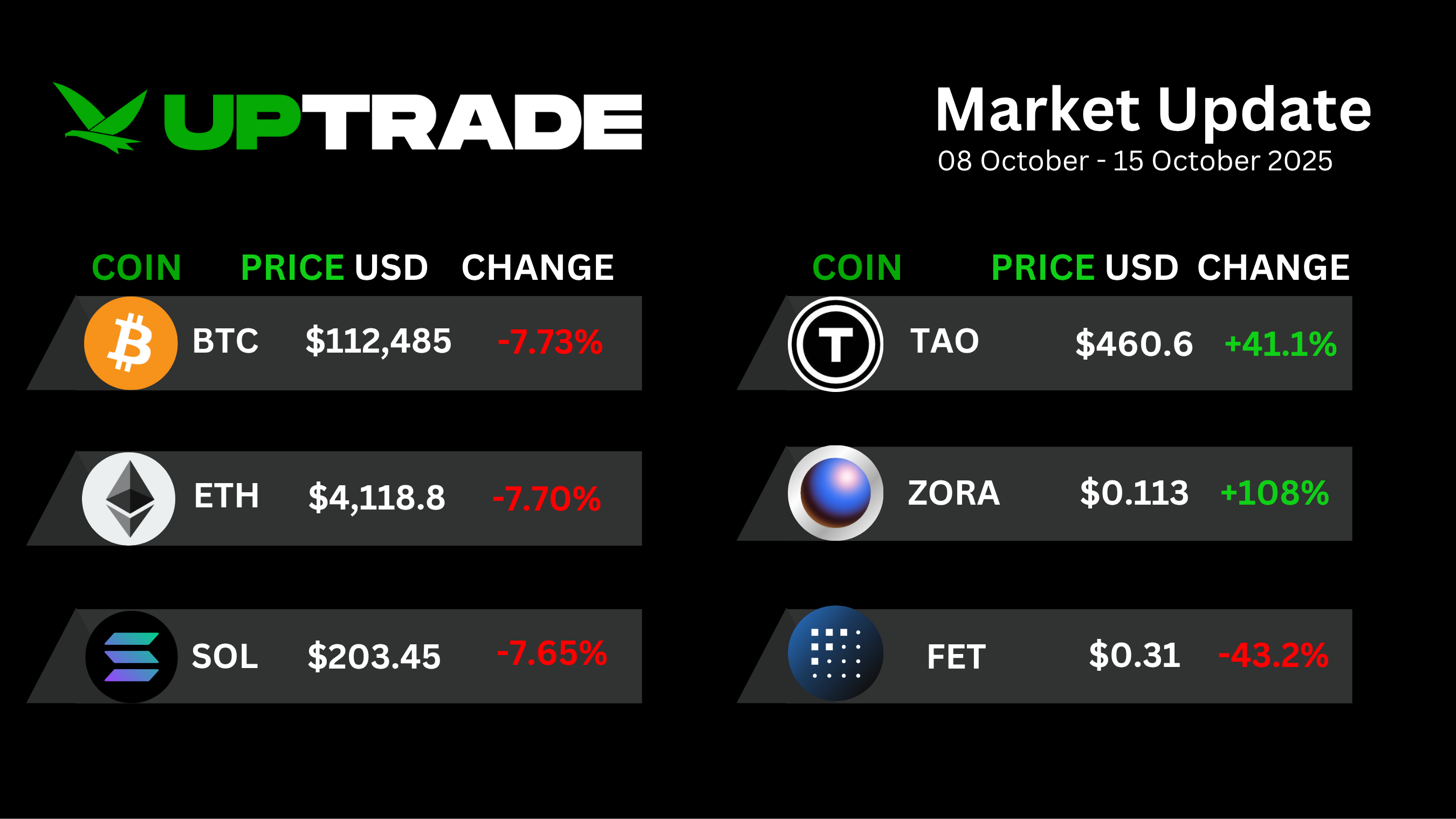
Historic Sell-Off Reshapes the Market: What Comes Next
Last week marked one of the most volatile periods for crypto in recent memory. Bitcoin (BTC) and Ethereum (ETH) both experienced sharp pullbacks, with BTC briefly dipping below $102K and ETH under $3,500, while many altcoins fell 50–80% within hours. What began as a reaction to renewed trade war headlines quickly turned into a $20 billion liquidation cascade, driven by overleveraged positions and thin weekend liquidity.
While the move caught many off guard, long-term holders remained steady, and on-chain data now points to early signs of stabilisation. With potential trade deals on the horizon, markets are beginning to digest the correction and refocus on the next wave of catalysts.
Weekly Price Update

Largest Crypto Crash in History, $20B Wiped
This week marked the largest single day crash in crypto history, with over $20 billion in leveraged positions wiped out in less than 24 hours. The selloff stemmed from a perfect storm of macro shocks and technical failures.
Total Liquidation Chart

It began when President Trump announced a 100% tariff on Chinese imports, a move that should have caused a moderate 10–15% correction at most. However, during the same period, Binance’s oracle system, which provides price feeds, was undergoing an upgrade, creating a critical window of vulnerability. Large deposits of wrapped SOL, ETH, and USDe were sent to Binance and dumped aggressively, briefly depegging several assets and instantly liquidating nearly $1B in positions.
Adding to the chaos, leverage across the market was at historic highs, with record open interest and farming activity across Aster, Lighter, and Hyperliquid. Many traders were running delta-neutral strategies, for example, going long SOL on Hyperliquid and short SOL on Aster, believing their positions were risk-free. When the cascade hit, these neutral setups unwound simultaneously, unleashing one of the largest leverage wipeouts ever recorded.
As Binance prices fell below other exchanges, market makers withdrew liquidity, spreads widened sharply, and altcoins collapsed, with many pairs dropping 50–80% within minutes, and some, like ATOM, falling 99%. The result was a violent, system-wide chain reaction unlike anything seen in previous cycles.
ATOM Chart Losing -99%

The key takeaway is that this was not a fundamentally driven crash, but one caused by historic leverage buildup and technical faults. With excessive leverage now flushed and funding rates reset, the market is shifting toward a more spot-driven environment.
Final Call to Join UpTrade Alpha Pro Early Bird
After instantly selling out our foundational tier of 50 members just six weeks ago, we’ve reopened a limited early bird offer, 25% off the Pro price with only 8 spots remaining before this tier permanently closes. UpTrade Alpha gives investors institutional-grade access to the markets, combining live analyst and broker watchlists, custom research reports, and exclusive webinars. Members also gain trading fee discounts, access to our private community channels, and upcoming insights powered by our in-house AI analyst.
We’re also excited to announce what’s next for our members. Alpha Pro subscribers will soon be the first to access the UpTrade Debit Card, enabling instant global crypto spending, along with integrated lending, borrowing, and yield-earning products, all within the UpTrade ecosystem.
Our team has just returned from Token2049 Singapore, where we captured the biggest trends and narratives shaping the next leg of the crypto cycle. Our event recap trailer is now live, offering a behind the scenes look at how Alpha members stay ahead of the curve.
- Click the play button to watch the trailer.
To secure your spot or learn more about joining Alpha, visit our website HERE, contact your UpTrade broker, or simply reply to this email. Spots are extremely limited and expected to fill quickly. You can also create a free UpTrade account to explore the platform, unlock a complimentary research piece, and preview our insights before upgrading.
U.S. Seizes $15B in Bitcoin - Largest Crypto Forfeiture in History
In a record-breaking move, the U.S. Department of Justice (DOJ) has seized 127,271 BTC (≈$15B) from Chen Zhi, founder of Prince Holding Group, marking the largest cryptocurrency forfeiture in U.S. history. For comparison, this surpasses the $3.6B Bitfinex hack seizure in 2022, previously the biggest on record. The Bitcoin already in government custody was tied to a massive “pig butchering” scam that trafficked victims and defrauded billions globally. This single operation boosts the U.S. government’s Bitcoin holdings to over 324,000 BTC (≈$36B), up from 197,000 BTC ($22B), positioning it among the largest Bitcoin holders in the world.
The criminal network behind the seizure ran one of the most sophisticated romance and investment scams ever uncovered. Victims were deceived through fake online relationships and persuaded to invest in fraudulent crypto platforms promising high returns. Behind the scenes, the operation was powered by forced labor, with trafficked individuals coerced into running scams under threat of violence inside what authorities described as “digital labor camps.” The network spanned multiple countries, funnelling profits into luxury assets, including a $16M London mansion. In coordination with UK authorities, the U.S. government has sanctioned 146 related entities to dismantle the broader network.
Under President Trump’s new executive order, forfeited Bitcoin can now directly contribute to the national reserve, transforming seized crypto into a strategic financial asset rather than an auctioned liability. This development also demonstrates how regulators can trace, recover, and secure stolen funds, enhancing institutional confidence in Bitcoin’s transparency and compliance potential.
Overall, this marks a significant policy shift in the U.S. approach to digital assets, from merely prosecuting crypto related crimes to actively integrating Bitcoin into national reserves. It represents another milestone in Bitcoin’s evolution, reinforcing its transformation from a speculative asset into a globally recognised, institutionally trusted store of value.
Fed Pivot Fuels Risk Appetite: U.S. Markets Near All-Time Highs
The U.S. economy continues to outperform expectations despite tariff driven price spikes and a gradual hiring slowdown. In his latest speech, Fed Chair Jerome Powell struck a cautiously optimistic tone, suggesting the Federal Reserve may soon halt its balance sheet reduction, effectively ending quantitative tightening (QT). This shift could pave the way for a return to quantitative easing (QE), where the Fed injects liquidity into the market through bond purchases. Historically, such policy pivots have fuelled rallies across equities, gold, and Bitcoin, as liquidity expands and investors rotate into risk assets.
Gold has surged to fresh all-time highs above $4,100, reflecting strong demand for hard assets during rising geopolitical and economic uncertainty. Meanwhile, U.S. equities remain remarkably resilient, with the S&P 500 now less than 2% away from all-time highs, showing continued investor confidence despite stretched valuations.
Looking ahead, Powell acknowledged that employment risks now rival inflation concerns, setting the stage for two additional 25bps rate cuts in October and December. Polymarket currently prices the probability of an October cut at 96%, reflecting broad market consensus for easing.
Polymarket October Rate Cut Odds

For crypto investors, this macro backdrop remains constructive. Lower yields, expanding liquidity, and a weaker dollar have historically supported Bitcoin and gold. As the Fed turns more accommodative, the next leg of market momentum could be driven by capital rotation into hard and digital assets, reinforcing crypto’s growing role as a hedge against monetary debasement.
Top Altcoin Updates: HYPE Upgrade, TAO Halving, XPL Fear, Monad TGE
Here’s a look at the latest updates from leading altcoins following last week’s historic market reset. Despite the volatility, several standout projects have shown resilience and renewed momentum.
Hyperliquid (HYPE) emerged as one of the top-performing exchanges during the crash, generating over $20 million in trading fees on the day of the selloff alone, reaffirming its dominance among perpetual DEXs. The team has also rolled out HIP-3, a major upgrade introducing permissionless listings for perpetual markets. Previously, only validators could list new markets, but now any user staking 500,000+ HYPE can do so, paving the way for equities, commodities, and custom assets to trade directly on-chain.
Bittensor (TAO) has been the strongest performer in the top 100 since the crash, rallying over 220% from the bottom and now trading above pre-crash levels. Up 41% this week, TAO continues to attract capital ahead of its first halving event in December, which will reduce mining rewards from 1 TAO to 0.5 TAO. This Bitcoin-like supply model enhances its scarcity narrative and positions TAO as a standout performer heading into year-end.
Plasma (XPL) faced one of the sharpest selloffs after rallying over 130% post-launch, yet its on-chain fundamentals remain strong. The network now ranks 5th in stablecoin TVL and 6th among all Layer 1s, reflecting steady adoption despite broader market fear. With sentiment at extreme lows, XPL’s setup could represent a contrarian accumulation opportunity for long-term investors.
Monad is a high-performance Layer-1 blockchain built by a team of high pedigree, aiming for 10,000 TPS and 1-second finality through parallel execution. With full EVM compatibility, it enables Ethereum developers to migrate seamlessly, removing friction for existing ecosystems. The network’s native token, MON, is set to launch soon and will also be available for trading on UpTrade at release, giving users access to one of the most anticipated blockchain launches this cycle.

PancakeSwap (CAKE) remains the leading DEX on BNB Chain, where liquidity has surged and BNB recently hit new all-time highs. The platform’s updated fee model now directs all fees to buybacks, creating consistent value accrual for holders. Meanwhile, Binance launched a $300M recovery fund for users impacted by last week’s liquidation cascade, alongside a $45M BNB Chain ecosystem airdrop, both of which have strengthened participation and sentiment across the Binance ecosystem.
Thinking About Trading
More insights
Discover our latest crypto research and insights from our expert team.

.jpg)
.jpg)
.jpg)
.jpg)
.jpg)
.jpg)
.jpg)
.jpg)
.jpg)

